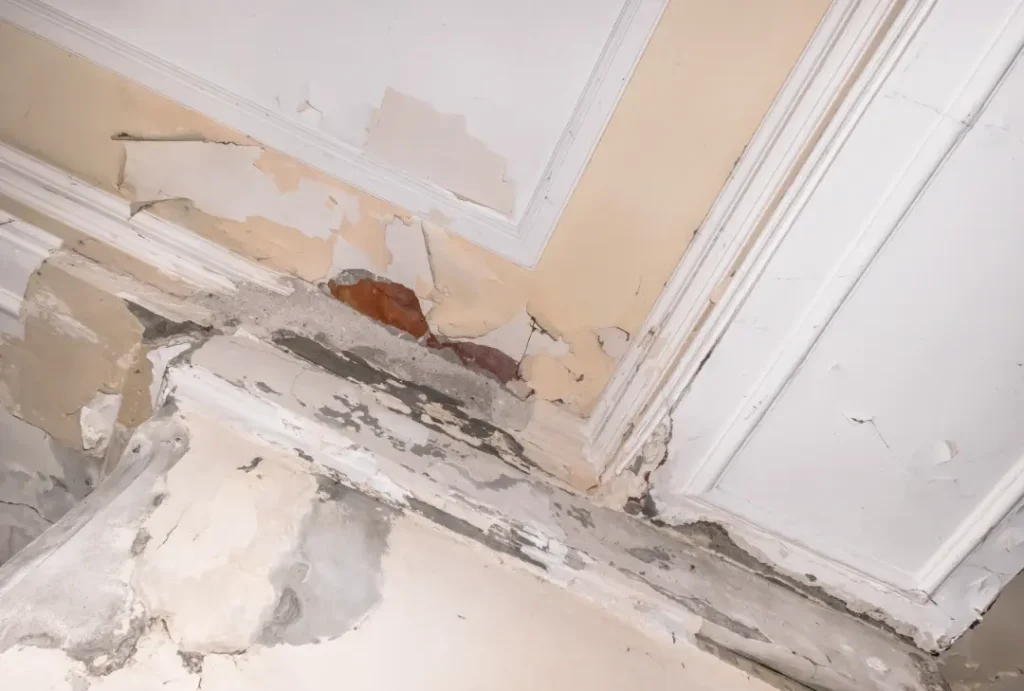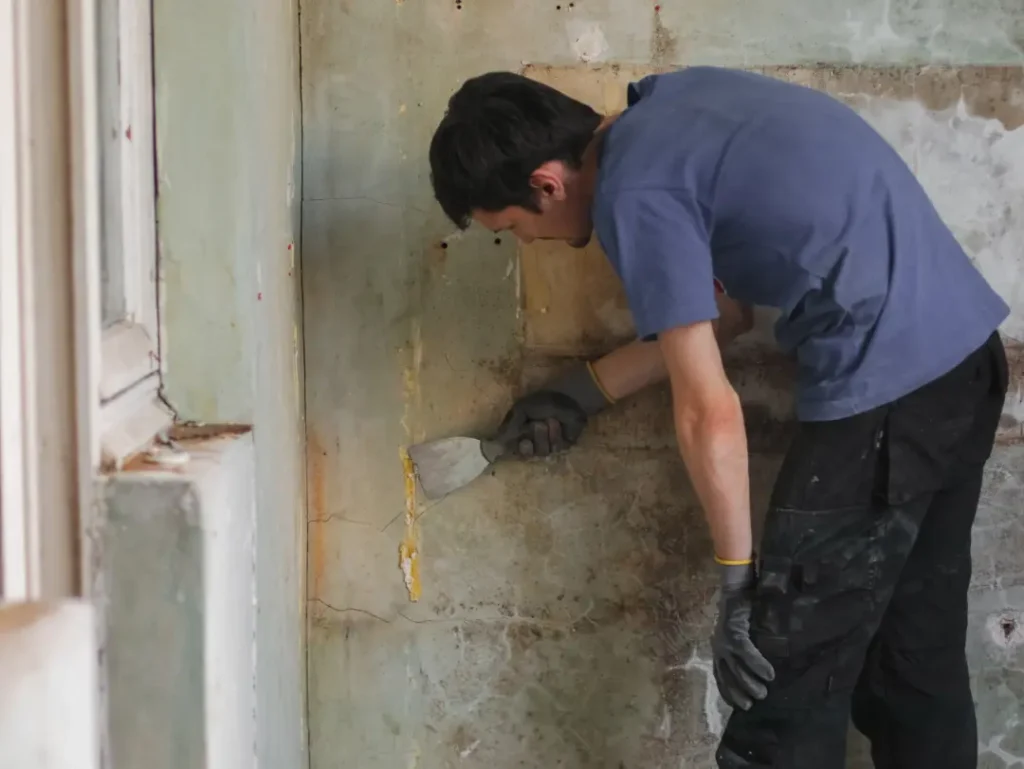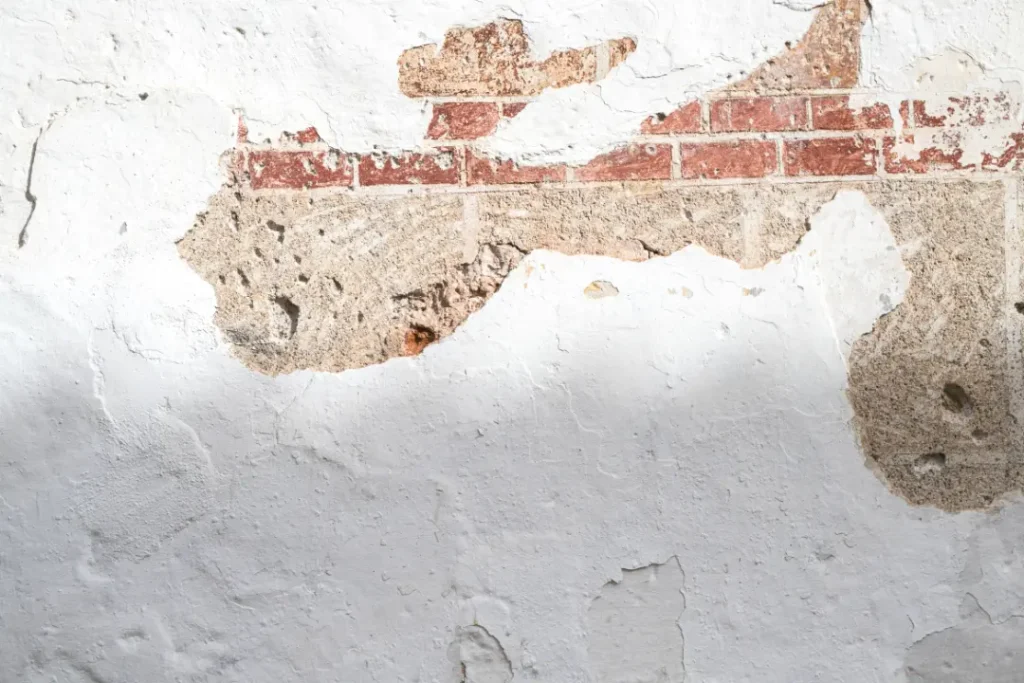Damp proofing is a vital technique designed to keep moisture from seeping into the interior of a building.
By safeguarding walls and floors, this process helps in maintaining the structural health of homes and other constructions. Damp proofing typically involves using specialized materials that form a protective barrier against moisture infiltration.
In this article, we will explain what damp proofing is, the methods used in damp proofing, common causes of dampness, and the benefits of implementing damp proofing solutions.
Key Takeaways
- Damp proofing prevents moisture ingress. It safeguards the structural integrity of buildings and helps arrest damage caused by rising damp.
- Common causes of dampness include condensation, rising dampness, and external issues such as leaks, stressing the importance of addressing moisture sources for effective damp proofing.
- Multiple damp-proofing methods are available, including damp proof membranes, paints, tanking slurry, and injection creams, each suited to specific moisture issues and building types.
What is Damp Proofing?
Damp proofing is a method used to control moisture in buildings. It is applied to walls and floors to stop moisture from entering the interiors. It involves materials that resist water without hydrostatic pressure. The main goal is to protect the structure of buildings from damage caused by rising damp.
One important element of damp proofing is the damp proofing course. This membrane is installed at the walls’ base of the walls to block rising damp. These membranes are carefully placed in the lower parts of walls to effectively prevent moisture ingress.

Common Causes of Dampness in Buildings
Damp in buildings can stem from various sources. Everyday activities, such as cooking and showering, contribute to excess moisture. This often leads to condensation. Another common culprit is damp rising. This type is characterised by hygroscopic salts that attract additional moisture. Indicators of rising dampness include tide marks of salts and damp patches on walls.
An existing damp proof course may fail over time due to age, bridging, or incorrect installation, making inspection essential before planning any new works. If compromised, a fresh damp proof course DPC can be installed to restore effective moisture resistance.
External issues like defective roofing, leaking gutters, and faulty downpipes also contribute to penetrating damp.
Older buildings with thin walls and porous materials are particularly vulnerable to penetrating damp. High winds make this issue worse by driving rain against the structure. Leaks and external defects, such as blocked gutters or cracks, can also lead to significant dampness problems. When cavity wall insulation is poorly installed or becomes saturated, it can trap moisture within walls and exacerbate damp problems. This makes it crucial to inspect insulation during any damp assessment.
Floors and walls can absorb moisture over time, leading to ongoing damp issues in homes and buildings. Structural dampness refers to the unwanted moisture that gets trapped inside a building. It’s a common problem that many property owners face.
It is important to understand what causes dampness to tackle the issue. By identifying the root cause, you can take proactive measures.
Types of Damp Proofing Methods
Several damp proofing methods are available, each tailored to address specific types of moisture issues. These include membrane damp proofing, integral damp proofing, and surface treatments. Each method serves a unique purpose in the damp proofing process.
Damp Proof Membranes
Damp proof membranes are a popular choice for preventing moisture ingress. They are water repellent and made from High-Density Polyethylene (HDPE). These membranes feature an egg box-like profile that enhances their effectiveness. Generally, they are fixed to internal walls after the damp source has been resolved. For concrete walls and floors, damp proof membranes must be paired with proper sealing techniques to ensure full protection against ingress. This is especially important in areas where the ground level sits higher than the internal floor.
Damp-proof membranes are especially useful for damp-proofing interior basement walls and waterproofing foundation walls. They function as a physical barrier, preventing moisture from penetrating walls and floors. This helps safeguard the building’s structural integrity. This method is particularly effective in areas prone to high moisture levels. It provides a long-lasting solution to damp-proofing problems.
Damp Proof Paints
Damp proof paints provide an effective surface treatment for addressing moisture issues in buildings. These specially designed paints create a barrier that helps prevent damp-related problems by sealing gaps and blocking moisture from penetrating the surface. However, it is crucial to avoid applying them directly to salt contaminated areas, as this can lead to de-bonding and a failure of the protective layer.
While damp proof paints offer surface-level protection, they should not be considered a substitute for full damp proofing treatment when underlying damp problems persist. Surface-only solutions may peel or crack if the underlying moisture pressure is not relieved.
Damp proof paints should be applied to the substrate first, followed by a layer of render or plaster for the best results. This approach not only enhances durability but also ensures the moisture barrier remains intact over time. It’s worth noting that extra care is needed when applying these paints on gypsum based materials, as prolonged exposure may cause deterioration. Following these guidelines can help achieve a long-lasting, moisture-resistant finish.
Tanking Slurry
Tanking slurry is a thick liquid made from cement polymers that is used to waterproof masonry walls. It acts as a waterproof barrier, sealing the masonry against water ingress. This method is particularly effective for basements and areas exposed to significant moisture.
Tanking slurry systems are designed to withstand large water pressures, making them particularly suitable for damp proofing basements and underground structures. They offer comprehensive coverage where traditional membranes may not suffice.
Applying a minimum thickness of 10mm cement-based render on top of the tanking slurry ensures its effectiveness. This creates a robust layer that can withstand water pressure and prevent moisture from penetrating the walls.
Injection Creams
Injection creams are a modern solution for combating rising damp. These chemical creams are injected into masonry walls to create a horizontal barrier against moisture. They expand within the masonry, forming a lasting shield that prevents damp from rising. Injection creams are ideal for remedial damp proofing, especially when the original DPC has broken down. They are minimally invasive and suitable for occupied properties where disruption must be kept to a minimum.
This method is extremely common and effective, providing a durable solution to moisture issues in walls. Injection creams are particularly beneficial for older buildings where traditional damp-proofing methods might not be feasible.
The Damp Proofing Process
The damp-proofing process involves several crucial steps to protect the property from moisture. It starts with a comprehensive assessment of the dampness source, followed by selecting the appropriate damp proofing method tailored to the specific moisture issue.

Site Preparation
Proper site preparation is essential for the success of any damp-proofing work. This begins with identifying the source of moisture and resolving it before addressing the damp inside the home. To site properly, surfaces must be cleaned of contaminants to ensure effective adhesion of damp proofing materials.
Proper substrate preparation is crucial for damp-proof paints to ensure they perform effectively. During preparation, surfaces contaminated by non pressurized moisture must be thoroughly dried to ensure adhesion of applied products. Failure to dry walls adequately can lead to premature failure of damp proofing materials.
An effective damp-proof course should be durable, water-resistant, and flexible to accommodate various surfaces. Choosing the right method depends on the specific moisture issue identified.
Installation Techniques
Installing a damp-proof membrane requires precise techniques to ensure it functions correctly. Damp-proof membranes, for instance, must be installed both above and below ground level to prevent moisture ingress. To be effective, the membranes should have a minimum thickness of 1,200 gauge.
They are flexible and long-lasting, capable of accommodating structural movement, which makes them a reliable choice for damp proofing.
For basement waterproofing to be effective, products must be compatible with the underlying concrete mix and applied with precision to avoid weak points. Where plastic sheets are used as barriers, they must be sealed and overlapped properly to ensure integrity.
Verification and Maintenance
Verification and maintenance are essential for the long-term effectiveness of damp proofing measures. Regular inspections help identify any issues early, allowing for timely repairs. Regular checks for rotting skirting boards can serve as an early warning sign of hidden rising damp problems. Addressing these promptly can prevent long-term damage to timber elements.
Ongoing maintenance practices, such as checking for leaks and ensuring proper ventilation, can significantly extend the life of damp-proofing installations.
Benefits of Damp Proofing
Damp proofing provides several important benefits. It helps prevent mould growth and structural damage by controlling building moisture levels. Effective damp proofing methods minimise water accumulation on walls and floors, significantly reducing the risk of dampness.
Damp proofing also plays a critical role in preserving exterior walls by stopping moisture penetration before it reaches interior finishes. When properly applied, it can help prevent moisture transmission through porous surfaces.
This practice preserves the structural integrity of the building and also improves indoor air quality, lowering the chances of respiratory problems and allergies.
Additionally, a property that is properly damp-proofed is more energy efficient, resulting in reduced heating costs and lower energy consumption. By eliminating dampness, you can enjoy a more comfortable living environment and lower carbon emissions. Investing in damp proofing pays off in both the short and long term.

Signs Your Property Needs Damp Proofing
Recognising the signs that your property needs damp proofing is crucial for maintaining its condition. Here are some common indicators of potential dampness:
- Discolouration on walls, manifesting as brown or yellow stains
- Peeling or bubbling paint, which suggests moisture problems, as it affects the paint’s adherence
- Efflorescence, a white powdery substance on walls, indicating moisture infiltration and potential damp issues
Other signs include mould or mildew on surfaces like walls and grout lines, which clearly indicate a damp environment. A consistent musty odour is another strong signal of dampness that should be investigated.
Condensation on windows, particularly in winter, can also indicate high humidity and potentially damp issues. Warped or buckled flooring, caused by excessive moisture, is another sign that damp proofing might be necessary.
Frequently Asked Questions
What is damp proofing?
Damp proofing is an essential moisture control technique that prevents moisture infiltration into building interiors, safeguarding the property’s structural integrity.
What are the common causes of dampness in buildings?
Common causes of dampness in buildings include condensation from daily activities, hygroscopic salts resulting from rising damp, external defects such as leaking gutters, and the use of porous building materials. Addressing these factors is essential for preventing damp-related issues.
What types of damp proofing methods are available?
Various damp proofing methods include damp proof membranes, paints, tanking slurry, and injection creams, all designed to effectively address specific moisture problems.
How do I know if my property needs damp proofing?
If you observe signs such as discolouration on exterior and interior walls, peeling paint, mould or mildew, musty odours, condensation, or warped flooring, your property likely needs damp proofing. Addressing these issues promptly can prevent further damage.
Conclusion
Damp proofing is an essential practice for maintaining the structural integrity and comfort of buildings. With various methods available, including damp proof membranes, paints, tanking slurry, and injection creams, property owners can choose the most suitable solution for their specific needs. Regular maintenance and timely intervention are key to ensuring long-lasting protection against moisture.

